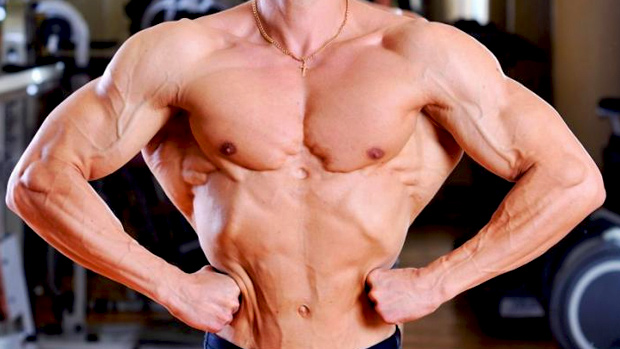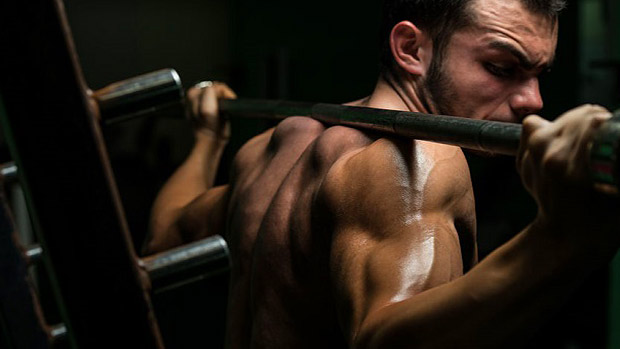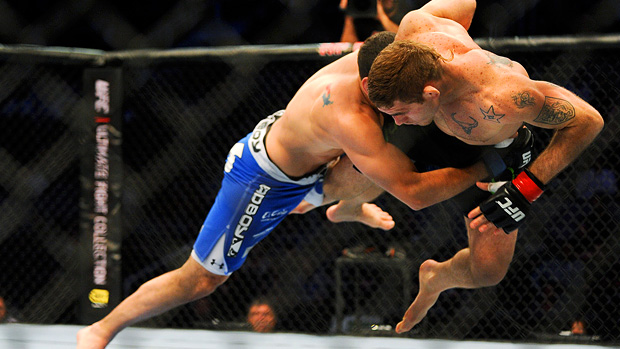Most of the athletes that I train – male and female – play either football or rugby. I didn't plan it that way, but that's how it's shaken out.
It might be because I have ties to the rugby and football communities in Central Pennsylvania. It might be because they're the only ones willing to train in the 500 square feet of cinder blocks and busted plaster that is our power lifting gym. (We have swords.)
Either way, I don't mind. It actually makes my job a lot easier; rugby and football training are similar. A player in each sport needs to be strong, powerful, and prepared to run into some other poor chump at high velocity. Sure, each sport has different energy system requirements, but that's not entirely my bag. They come to me to build armor.
Much of that armor is built around the shoulder girdle. Even for shoulder-pad wearing football players, the stress of tackling, being tackled, and blocking can lead to shoulder pain and players riding the pine.
To that end, building large, strong deltoids and traps helps protect the shoulders from injury – and looks undeniably awesome as well.
What We Know
Before we get into training the delts and traps, let's look at what the delts and traps do, and their fiber type compositions.
Deltoids
The anterior and middle deltoids have two main jobs: abduct and flex the humerus. They work in conjunction with the muscles that rotate the scapulae, as well as the supraspinatus, to make this magic happen.
The posterior delts externally rotate the humerus and create extension at the glenohumeral joint.
A 2007 cadaver study showed that the delts are primarily composed of slow-twitch fibers, even though the split is pretty close (3). These bad boys need serious tension, sometimes extended tension, to grow.
Trapezius
The traps rotate the scapulae as well as the serratus anterior (which actually has a stronger upward rotation moment). Trapezius fibers run in three different directions: upper-trapezius fibers travel medially and superiorly, middle-trapezius fibers travel medially, and lower-trapezius fibers travel medially and inferiorly.
Because of the orientation of their fiber direction, each portion of the trapezius is responsible for a different scapular movement. Upper-traps help elevate the scapula while the mid-traps help retract the scapula and the lower-traps help depress the scapula (along with aiding in retraction) (2).
Most cross-sectional and histochemical studies of the traps expound all fiber orientations as primarily slow twitch (1). Since they're postural muscles, this makes a great deal of sense.
Making Kinesiology our Bitch
To build massive, strong, and healthy shoulders, we have to own our physiology. It requires mastery of the biomechanical and physiological factors we discussed above. Science is complicated, but applying it to training – at least for our current purpose – is easy. Load each shoulder movement – sometimes fast, sometimes slow, and sometimes without any movement at all.
Below are the staple exercises I use to help rugby and football players build cobra traps and cannon ball delts.
Some Thoughts on Deadlifting
I'm not going to include a deadlifting program in a shoulder training article but the training effect can't be denied. High volume deadlifting – not necessarily high-rep sets – turns the traps into monsters. If you're not deadlifting on the reg, you're missing out on a huge opportunity to build massive traps.
Build appreciable deadlift volume without crushing your body by using Sadiv Sets:
- Load a bar with 60% of your deadlift 1 RM and set a timer for 12 minutes.
- Perform as many single reps as possible in 12 minutes, shooting for a minimum of 20 reps.
Each rep should be performed with maximal speed from the floor. Release the bar between sets, rest until you're ready, and repeat. Once 12 minutes are up, record your score.
Alternatively, you can use deadlift cluster sets, a la Bret Contreras. Both have worked wonders for me.
Overhead Pressing
My athletes, excluding quarterbacks, press overhead twice per week – once as a main exercise with a barbell, and once as an assistance exercise with either kettlebells or dumbbells.
You can build delts and traps without overhead pressing, but it's a hell of a lot harder. Not to mention, overhead pressing is something every capable, warm-blooded male should do.
Loaded Carries
Loaded carries are great for putting the traps under tension, but they serve well as a pre-hab exercise, too. Tension created in the grip causes a co-contraction (irradiation) that activates the rotator cuff muscles, building stability around the glenohumeral joint.
Shoulder Girdle Tri-sets
Tri-sets started, as many training tools do, as an experiment posed as a solution to a problem. A few years back I was training a large group of football players. They trained at the facility I worked at, as well as at their high school. They were being crushed with volume, especially pressing volume.
Their shoulders, however, still sucked. None of them filled out a T-shirt. Their delts were small, traps nonexistent. We didn't have a lot of time together – two hours per week for a summer – and we needed to make drastic changes. But I couldn't program even more pressing.
Once per week, we finished our sessions with tri-sets: a complex of three shoulder exercises that attacked three different movements or stability functions of the shoulder. By the end of the summer their extra-medium Under Armor shirts had a shelf to hang from.
After that, tri-sets solidified their place in my programming Rolodex.

The Program
Here's how I take all the above gibberish and put it into action. Here's an eight week trap and delt intensive upper-body training program. It's not your typical bodybuilding "shoulder" routine, but if you're pining for bigger traps and delts, it definitely gets the job done.
Note: If you haven't done a lot of shoulder-intensive work lately, start easy on this program. Cut a few sets out here or there, and maybe drop a few reps. Then, recycle the program once you've acclimated.
The Warm-up
Here's a quick warm-up that will prime you for upper-body training.
| Exercise | Sets | Reps | |
| A | Bench Thoracic Extension Mobilization | 1 | 8 |
| B | Quadruped Thoracic Extension Rotation | 1 | 5 * |
| C | Quadruped Rotating Pec Stretch | 1 | 5 * |
| D | Scapular Push-ups | 1 | 8 * * |
| E | 4-Way Band Pull-apart | 1 | 10 * |
| F | Get-up to Bridge | 1 | 5 * |
* each way
* * 3030 tempo
Complete all exercise with minimal rest in between. If you need a reference for how to complete any of the exercises, shoot me a comment in the Livespill.
If you still don't feel prepared to heavily press or pull, repeat the warm-up.
Week 1-4
Day 1
| Exercise | Week 1 | Week 2 | Week 3 | Week 4 | |
| A | Standing Overhead Press | 20 minutes of singles @ 7 | 20 minutes of singles same weight as week 1, get more reps | 20 minutes of singles with 5–10 more pounds. Match or beat week 2 reps | 10 minutes of singles at week 3 weight |
| B1 | One-Arm Rows | 3 x 8, 6, 15 | 3 x 8, 6, 15 | 3 x 8, 6, 15 | 1 x 15 |
| B2 | Assorted Push-ups | 4 x 12-15 | 3 x 12-15 | 4 x 12-15 | 2 x 12-15 |
| C1 | Assorted Pull-ups | 30 total bodyweight reps |
25 total bodyweight reps |
40 total bodyweight reps |
20 total bodyweight reps |
| C2 | KB/DB Rack Walk | 3 x :30 | 3 x :30 | 3 x :45 | 1 x :45 |
| D | Tri-set: Farmer's Walks,
Band pull-apart behind neck, Band Front Raises |
FW: x :40
PA: x 15 (2020) CLR: x 10 (2020) Repeat 2x |
FW: x :45
PA: x 15 (2020) CLR: x 12 (2020) Complete 1x |
FW: x :45
PA: x 15 (3030) CLR: x 12 (2020) Repeat 2-3x |
Omit |
- For an esplanation of the RPE scale (why there's an @ 7 or @ 8 beside exercise volumes) check out Mike Tuscherer's article.
- Get at least 20 overhead press singles on week 1. Rest at least 15 seconds between reps. If bar speed slows, take longer breaks between reps.
- Rest 60-90 seconds between sets of B1, B2, C1, C2.
- For an explanation of 8, 6, 15 one-arm rows read this article.
- Cut all pull-up sets before fatigue affects form.
- Rest for as long as it takes you to complete each tri-set.
- If you don't have access to chains, you can substitute dumbbells or kettlebells.
Day 2
| Exercise | Week 1 | Week 2 | Week 3 | Week 4 | |
| A1 | Floor Press | 4 x 6 @ 8 | 3 x 6 @ 8 | 4 x 8 @ 8 | 2 x 6 @ 7 |
| A2 | Thoracic Mobility Drill | 4 x 5 | 4 x 5 | 4 x 5 | 2 x 5 |
| B1 | One-Arm DB Z Press | 3 x 8 @ 7-8 | 3 x 6 @ 7-8 | 3 x 10 @ 7-8 | 2 x 8 @ 7 |
| B2 | Assorted Pull-ups | 30 total bodyweight reps | 25 total bodyweight reps | 40 total bodyweight reps | 20 total bodyweight reps |
| C1 | Inverted Rows | 4 x 12-15 (2210) | 3 x 12-15 (2210) | 4 x 12-15 (3210) | 2 x 12-15 (3210) |
| C2 | KB/DB Get-up to Bridge | 3 x 5 each @ 7 | 3 x 5 each @ 7 | 3 x 6 each @ 7 | 2 x 5 each @ 7 |
- Rest 90-120 seconds between floor press sets. Fill that time with thoracic mobility drills.
- Rest 60-90 seconds between sets of B1, B2, C1, C2.
- Cut all pull-up sets before fatigue alters form.
- Inverted rows are not loaded.
Weeks 5-8
Day 1
| Exercise | Week 5 | Week 6 | Week 7 | Week 8 | |
| A | Standing Overhead Press | 20 minutes of doubles @ 7 | 20 minutes of doubles same weight as week 5, get more reps | 20 minutes of doubles with 5–10 more pounds. Match or beat week 6 reps | 10 minutes of doubles with week 7 weight |
| B1 | Dead Stop One-Arm Row | 3 x 8 @ 8 | 3 x 6 @ 8 | 3 x 10 @ 8 | 2 x 8 @ 7 |
| B2 | Assorted Push-ups | 3 x a few reps before failure | 2 x a few reps before failure | 3 x a few reps before failure (beat week 5 rep total) | 2 x 10 |
| C1 | Assorted Pull-ups | Match 1/3 of push-up reps |
Match 1/2 of push-up reps |
Match 1/3 of push-up reps |
Match push-up reps |
| C2 | KB/DB Waiter/Rack Walk | 3 x :20 | 2 x :30 | 3 x :45 | 1 x :45 |
| D | Tri-set: Farmer's Walks,
Band pull-apart behind neck, Band Front Raises |
FW: x :45
PA: x 15 (2020) BFR: x 10 (2020) Repeat 2x |
FW: x :60
PA: x 15 (2020) BFR: x 12 (2020) Complete 1x |
FW: x :60
PA: x 15 (3030) BFR: x 12 (2020) Repeat 2-3x |
Omit |
- Get at least 12 overhead press doubles on week 1. Rest at least 15 seconds between sets. If bar speed slows, take longer breaks between sets.
- Rest 60-90 seconds between sets of B1, B2, C1, C2.
- Cut all pull-up sets before fatigue alters form.
- Rest for as long as it takes you to complete each tri-set.
- If you don't have access to bands you can substitute dumbbells or kettlebells.
Day 2
| Exercise | Week 5 | Week 6 | Week 7 | Week 8 | |
| A1 | Incline Barbell Press | 4 x 6 @ 8 | 3 x 6 @ 8 | 4 x 8 @ 8 | 2 x 6 @ 7 |
| A2 | Thoracic Mobility Drill | 4 x 5 | 4 x 5 | 4 x 5 | 2 x 5 |
| B1 | Standing One-Arm DB Overhead Press | 3 x 8 @ 7-8 | 3 x 6 @ 7-8 | 3 x 10 @ 7-8 | 2 x 8 @ 7 |
| B2 | Assorted Pull-ups | 30 total bodyweight reps | 25 total bodyweight reps | 40 total bodyweight reps | 20 total bodyweight reps |
| C1 | One-Arm Inverted Rows | 3 x 5-8 each (2010) | 3 x 5-8 each (2010) | 3 x 6-10 each (2010) | 2 x 5 each (2010) |
| C2 | KB/DB Get-up to Kneel | 3 x 5 each @ 7 | 3 x 5 each @ 7 | 3 x 6 each @ 7 | 2 x 5 each @ 7 |
- Rest 90-120 seconds between incline barbell press sets – fill that time with thoracic mobility drills.
- Inverted rows are not loaded.
Conclusion
For contact athletes, building mass around the shoulder girdle is important for performance and safety. Big traps and delts can also take a decent physique to the next level in terms of size and intimidation – a good combination both in the gym and on the field.
Give this program a shot for eight weeks and shoot me a note about your results. My guess is you'll fill out your prized pink polo and soon be in need of a new set of shoulder pads.
References
- Lindman, R., Eriksson, A., & Thornell, L. E. (1990). Fiber type composition of the human male trapezius muscle: enzyme-histochemical characteristics. Developmental Dynamics, 189(3), 236-244. doi: 10.1002/aja.1001890306
- Neumann, D.A. (2002). Kinesiology of the musculoskeletal system: Foundations for physical rehabilitation. St. Louis: Mosby.
- SRINIVASAN, R. C., LUNGREN, P. T., LANGENDERFER, J. E., & HUGHES, R. E. (2007). Fiber type composition and maximum. Clinical Anatomy, 20, 144-149.




